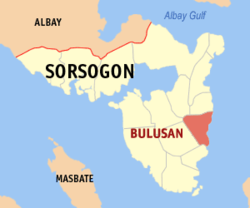Bulusan, Sorsogon
|
Bulusan Banwa nin Bulusan (Bikol) Bayan ng Bulusan (Filipino) |
||
|---|---|---|
| Municipality | ||
| Municipality of Bulusan | ||
 |
||
|
||
 Map of Sorsogon showing the location of Bulusan |
||
| Location within the Philippines | ||
| Coordinates: 12°45′N 124°07′E / 12.750°N 124.117°ECoordinates: 12°45′N 124°07′E / 12.750°N 124.117°E | ||
| Country |
|
|
| Region | Bicol (Region V) | |
| Province | Sorsogon | |
| District | 2nd District of Sorsogon | |
| Founded | 1630 | |
| Barangays | 24 | |
| Government | ||
| • Mayor | Michael Guysayko | |
| Area | ||
| • Total | 96.30 km2 (37.18 sq mi) | |
| Population (2010) | ||
| • Total | 22,089 | |
| • Density | 230/km2 (590/sq mi) | |
| Demonym(s) | Bulusanon / Buluseño | |
| Time zone | PHI (UTC+8) | |
| ZIP code | 4704 | |
| IDD : area code | 56 | |
| Income class | 4th class (per NSCB, 2010) | |
Bulusan is a fourth class municipality in Sorsogon Province, Philippines. According to the 2010 census, it has a population of 22,089 people.
It is bordered by the towns of Barcelona in the north and going counterclockwise, the towns of Casiguran, Juban, Irosin and Santa Magdalena. The islets of San Bernardino, about 15 kilometres (9.3 mi) off the coast, falls under the jurisdiction of Bulusan.
Bulusan is politically subdivided into 24 barangays; 8 of them are located in the Poblacion area.
Long before the Spaniards ever set foot on the archipelago, the natives of Bulusan were already living in organized though scattered settlements. Some lived in what used to be Inarado (now Licod or San Rafael), others in Ilihan, some in Pinayagan, and still a number lived in Capangihan - a place near the Paghasaan and Bayugin Rivers. Familiarity with the town's terrain will prove what these settlements have in common: that of being distant from the seacoast and being uplands. The reason behind this occurrence could very well be the presence of Moro pirates who used to attack the town especially the coastal areas, robbing the natives of their gold & whatever else came to be lying around, and burning the houses afterwards. Due to these Moro-related disasters, it was certainly a wise move to locate the settlements on higher ground.
Recent excavations yielded artifacts such as platters, jugs, plates, and vases made from china and earthen burial jars in what used to be Inarado. These finds further strengthened some claims that the Chinese and the people in this part of the country were already engaged in trade even before the Cross & Sword reached these shores.
Bulusan, like the rest of Sorsogon, was still a part of the province of Albay till October 17, 1894. In Inarado, the fourth parroquia [ parish ] of the present Province of Sorsogon, was established in the year 1630. After being merely a part of Casiguran (established in 1600), Bulusan became an independent parish following Bacon (established in 1617) and the parish of Sorsogon (established in 1628). It became a separate pueblo civil [town] in 1631. The new parish was then placed under the tutelary of St. James, the Greater - the National Patron Saint of Spain. A certain Fr. Miguel de Sta. Ana became its first parish priest, exercising one-man authority over ecclesiastical and civil functions. The people also selected the first executive of the place, a gobernadorcillo.
...
Wikipedia


